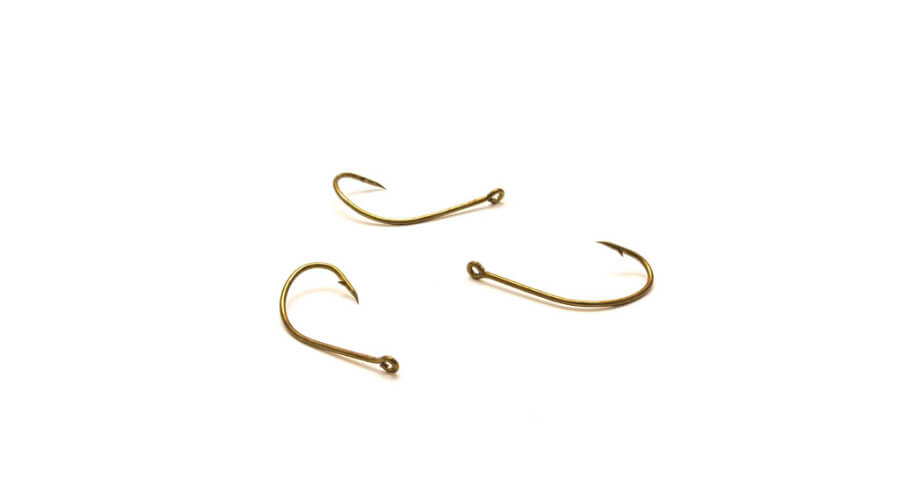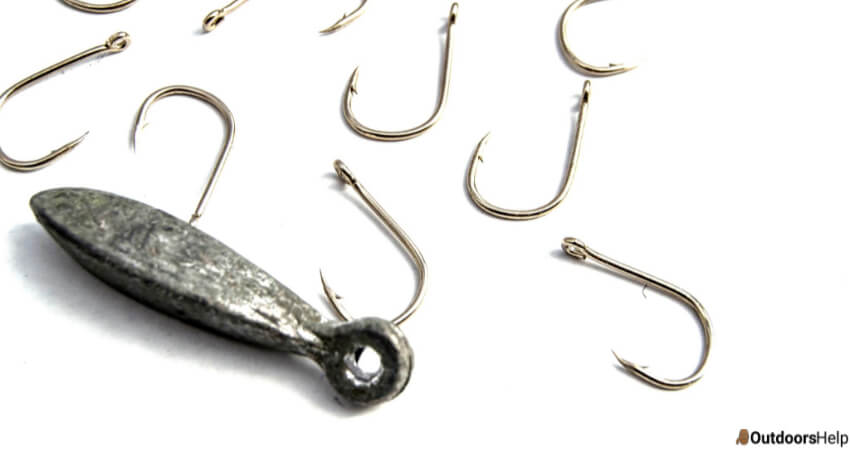There’s an enormous variety of hooks in the fishing world, ranging from the simplest to more complicated designs. Fishing hooks are manufactured for various purposes: from general fishing to minimal and specialized applications. Are you curious to find out what your favorite hook is made of? Or what are some of the specialized hooks? Everything there is to know about fishing hooks and more is explained in this article. Please stick with us to discover even more helpful information.
Fishing hooks are made in different sizes, designs, shapes, and materials, depending on the application. They can be made from steel alloyed with vanadium, stainless steel, or high-carbon steel.
A fish hook is a gear used to catch fish either by jabbing them through the mouth or more rarely by grasping the fish’s flesh. Anglers use them while fishing in both fresh and salty water. They are typically attached to the fishing line or lure to connect the angler to the caught fish. Depending on the intended purpose of hooks, they differ in size, shape, and materials. Most hooks designed for saltwater fishing have a corrosion-resistant surface coating to keep them from rusting.
Parts Of A Fishhook:
below is a summary of the main components of a hook and their description. In most cases, fishing hooks are described using their part, for example, out-turned eye, long shank, hollow or wide gape:
| Part: | Description: |
| Eye | This is the point where the hook is connected to a fishing line. |
| Point | A sharp end which pierces fish’s flesh or mouth and secures the fish |
| Bend and shank | A portion of the hook that connects point and eye. |
| Barb | A projection that extends backward from the point and secures fish from unhooking. |
| Gape | Distance between shank and point. |
How Are Hooks Made?
When you peek inside the tackle box of a serious angler, you’ll find a wide variety of hooks in all shapes and sizes. Hooks are arguably fishing’s most important piece of terminal tackle. But have you ever wondered how these useful little pieces of metal are made? Let’s get right into it!
1. High-Carbon Steel Hooks:
The process of making hooks is not overly complicated; straight lengths of wire are cut into pieces, and a point is honed on one end and an eye formed on the other. To create the hook’s shape, the wire is then bent around a cam. They’re tempered or heat-treated and then cold compressed to strengthen the metal in saltwater hooks. Concentrating the carbon and removing impurities, tempering alters the metal molecularly. They’re then ready to be plated after careful cooling and intermittently dipping in oil.
Carbon steel hooks have to be coated to protect them from corrosion by saltwater. The coatings vary and can either be bronze, zinc, nickel, tin, or an alloy of two metals.
Pros:
1. They are strong in that a higher carbon content equals a more rigid metal alloy.
2. Wire is proportionally thinner, and this much helps in hooking fish.
3. Less expensive than stainless steel.
Cons:
Costing can be damaged by sharpening
2. Stainless-steel hooks:
These hooks contain nickel as a critical ingredient that wards off the rust. If a stainless blend hook has more nickel, the less its chances of corroding.
Pros:
1. Corrosion-resistant compared to carbon-steel hooks.
2. Highly recommended for saltwater fishing.
3. They have a sharper point.
Cons:
1. Some fisheries prohibit the use of these hooks.
Types Of Fishhook:
There are wide varieties of hooks that differ in the eye type, shape, materials, points and barbs, and intended application. Factors that contribute to a hook’s design include Corrosion resistance, strength, weight, hook efficiency, and whether the hook is being used for specific types of bait, flies, or lures.
| Hook Type: | Description: |
| Circle | It is considered the most fish-friendly hook because its circular design ensures it doesn’t harm fish even if it is swallowed. It has a sharp tip and is circular to ensure that the hook point only hooks onto an exposed surface, typically at the corner of the fish’s mouth. You don’t need much of a hook set because the fish will often hook themselves naturally. Target species: large freshwater and saltwater gamefish |
| Baitholder | They have multiple barbs at the bend area and on the hook’s shank to keep the bait from falling off the hook. Target species: panfish, catfish, trout, bass, and walleye |
| Treble | Consists of three hooks, bends, and points with a common eye. They are mostly used for artificial lures like topwater, spinners, crankbaits, and attaching baits; the three hooks provide excellent bite coverage. When using trebles on different water bodies, always check your fishing regulations. Target species: all game fish |
| Jig | Most common hooks are used currently. They have acutely angled shanks that align the eye and point for consistent hookups. Target species: all game fish |
| Worm | Worm hooks are versatile performers when rigging plastics. They can be used in timber, rocks, and even weeds. They have a wider gap providing clearance between the eye and hook point. Target species for worm hooks are Largemouth Bass, Redfish, speckled trout, and Smallmouth Bass. |
| Octopus | Have a short shank with a slightly lower section wider gap than the average J-hook or bait hook. It is ideal for trying egg loop knots which are great for holding bait and yarn for the eye points away from the hook point. Designed for live baiting using fragile baits likes leeches or minnows. They are recommended for various species with smaller mouths like trout, steelhead, and salmon and not fish species with big mouths like bass. |
Types Of Hook Points:

Over the years, various hook points have been developed as they’re the business end of your whole setup. Let’s have a clear and in-depth look at some of them:
1. Spearpoint:
Giving you decent penetration while limiting the fish, the spear point runs straight up from the throat. They are also more elaborate and more comfortable to sharpen.
2. Hollowpoint:
Cutting through soft-mouthed fish and staying in place once they’re there, they are bent in a spike that curves down to the barb.
3. Needlepoint:
These cause minimal damage once they’re through and are designed to pierce easily. Reducing the harm to the fish and making it harder for it to throw the hook, they keep the hole small and taper in slightly towards the shank.
4. Knife-Edge Point:
They’re made for maximum penetration as they mean business and are sharpened on both sides, pointed away from the shank. One disadvantage about them is the significant damage they cause to the fish.
5. Rolled-In Point:
With a minimal amount of pressure, these hooks pierce deeply. They keep your force directly in line with its path through a fish’s mouth as the tip faces towards the hook eye. These hooks are perfect for fish that lash about when taken to the boat.
Conclusion:
Different types of fishing hooks are made differently depending on their specific application. The manufacturers use various designs and materials to make hooks best suited for their use. Know that you know how your favorite hooks are made, ensure you store them properly to reduce the risk of damage. We advise storing your hooks separately in plastic bags when they are dry. Doing this ensures they do not rust and will last longer. Keep your hooks primed and ready for action so that the next time you want to go fishing, everything will be set.

